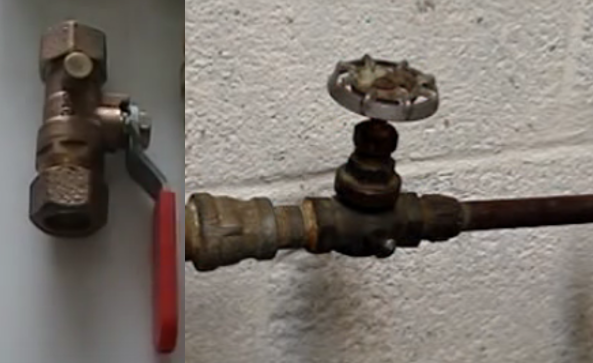
Water in your home is a significant problem, able to cause costly damage to your home’s structure and its contents.
When a water leak occurs, your first step should be to shut off the water to minimize damage.
In some cases, you might need to shut off water to a specific fixture that’s leaking.
In more serious incidents, you’ll need to find the water shutoff valve for your entire house.
In this post, we’ll help you understand the different types of water shutoff valves and how to use them to prevent or mitigate a flooding catastrophe.
Finding Your Water Shutoff Valves
Every plumbing fixture in your home has a water shutoff valve, and knowing the location of this valve is important should a leak occur.
Generally, you can identify the valve by looking for a plastic or chrome-plated valve handle that connects to the water supply line.
Look behind or under the toilet or sink, for example, to find this valve.
Note that sinks usually have two shutoff valves: one for hot water and one for cold water.
Operating these valves can vary depending on their design.
There may be a round or oval-shaped valve handle that you turn clockwise to close, and counterclockwise to reopen.
Some modern plumbing shutoff valves may feature a flat knob that you pull out in order to close.
Others may look like flat levers, which you can turn perpendicular to the supply line to reach the closed position.
In many cases, operating instructions may be indicated directly on the valve.
For the best protection, you’ll want to identify where to find the water shutoff valve for your entire home.
Locations vary from residence to residence, but many homes feature a main shutoff valve inside the building, and where this valve is located depends on your type of residence.
If you have a basement, your main shutoff valve may be located by the front foundation wall.
Although there is no standard location, homes on slabs may include the main water shutoff valve by the water heater or the kitchen sink.
If you can’t find the main water shutoff valve inside your home, head to your water meter.
Your water meter will likely be located close to the street in an underground box.
It may also be under a metal plate in your driveway, yard or sidewalk. Once you open the meter, you should see a top shutoff valve that can stop water flow to your house.
Tip: As with other types of shutoff valves, your main water valve can usually be turned clockwise or perpendicular to the line in order to turn off your entire water supply.
Understanding When to Shut Off Water
Now that you know where to find water shutoff valves in your house and how to operate them, it’s important to be aware of the situations when you might want to shut off your water.
To begin with, it’s a good idea to turn off the water as soon as you notice a leak, no matter how minor.
If the leak is clearly coming from a specific plumbing fixture, you can shut off water to that fixture to stop the water flow.
On the other hand, if leaking is significant or you can’t identify the source of the leak, you should use the main water shutoff valve for the entire house.
Make sure every family member knows where these shutoff valves are located so that a minor water incident doesn’t result in major damage.
Consider writing out instructions so everyone in the household knows how to act if they spot a leak.
Test these values at least twice a year to ensure proper operation.
Finally, when you’re heading out of town, use these valves to shut off water flow so that you don’t come home to water damage or a flood.
Don’t wait for an emergency.
Identify where and how to turn off your home’s water supply so you can minimize the potential damage to your home and possessions.
If you notice signs of water damage inside your home, contact the experienced professionals at ServiceMaster Restore® to safely and effectively clean up the mess before dangerous mold or structural damage sets in.
